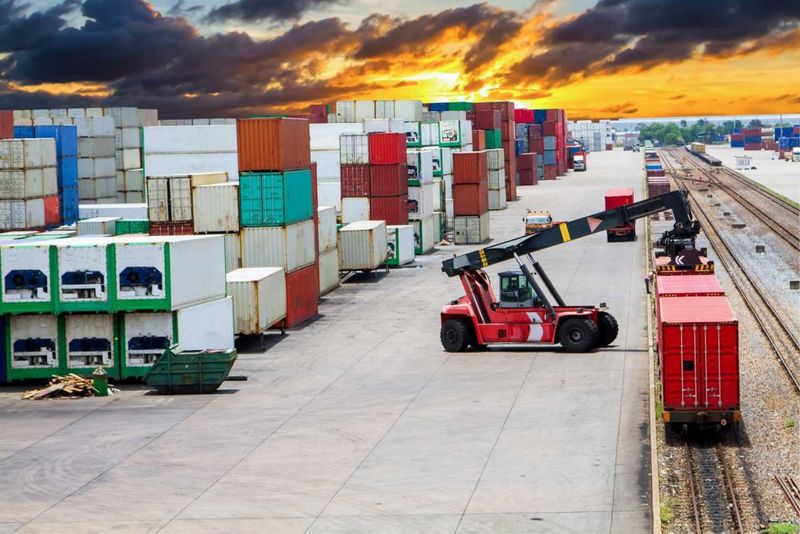In the realm of modern logistics and transportation, intermodal container drayage stands out as a pivotal component in the movement of goods across various modes of transportation. This article explores the definition of intermodal transportation and delves into its key advantages, focusing particularly on cost reduction, increased efficiency, and sustainability. Case studies from YK Freight will illustrate successful implementations of intermodal drayage, highlighting practical examples of its benefits. Finally, the article concludes with insights into how YK Freight leverages intermodal drayage to optimize logistics operations.
Definition of Intermodal Transportation
Intermodal transportation refers to the movement of freight using multiple modes of transportation, such as truck, rail, and ship, typically coordinated under a single transport document and using standardized containers. This approach allows for seamless transfer of cargo between different modes, enabling greater flexibility and efficiency in logistics operations.
Key Advantages
Cost Reduction
One of the primary advantages of intermodal container drayage is cost reduction. By integrating multiple modes of transportation, companies can achieve significant savings compared to using a single mode. Here’s how:
- Lower Transportation Costs: Utilizing rail or water transportation for long-distance hauls can be more cost-effective than relying solely on trucks, which are more expensive per mile.
- Reduced Fuel Consumption: Trains and ships are generally more fuel-efficient per ton-mile than trucks, leading to lower fuel costs and reduced carbon emissions.
- Economies of Scale: Standardized container sizes allow for efficient stacking and handling of cargo, maximizing space utilization and reducing overall shipping costs.
Increased Efficiency
Intermodal drayage enhances operational efficiency across the supply chain:
- Faster Transit Times: By combining different modes of transport, intermodal transportation can often provide faster delivery times compared to relying solely on trucks, especially over long distances.
- Reduced Congestion: Shifting a portion of freight from trucks to rail or waterways can alleviate congestion on highways, contributing to smoother traffic flow and fewer delays.
- Improved Inventory Management: Predictable transit times and reliable scheduling enable better inventory planning and management, reducing stockouts and excess inventory.
Sustainability
In today's environmentally conscious world, sustainability is a key consideration for businesses. Intermodal drayage offers several environmental benefits:
- Lower Carbon Footprint: Utilizing rail and water transportation produces fewer greenhouse gas emissions per ton-mile than trucks, contributing to reduced overall carbon emissions.
- Energy Efficiency: Trains and ships are more energy-efficient per unit of cargo transported, further reducing environmental impact.
- Promotion of Green Initiatives: Companies that adopt intermodal transportation can enhance their corporate social responsibility profiles by demonstrating a commitment to sustainable practices.
Examples of Successful Use of Intermodal Drayage
YK Freight Case Studies
YK Freight, a leading logistics provider, exemplifies the successful implementation of intermodal drayage in its operations. Here are two case studies showcasing their achievements:
Case Study 1: Interstate Freight Movement
YK Freight partnered with a major retailer to streamline the transportation of goods between distribution centers located across multiple states. By utilizing a combination of trucking and rail services, YK Freight reduced transportation costs by 15% and improved delivery times by 20%. This approach not only enhanced operational efficiency but also minimized the retailer's carbon footprint, aligning with their sustainability goals.
Case Study 2: International Shipping Optimization
For an electronics manufacturer exporting products to overseas markets, YK Freight implemented a comprehensive intermodal drayage strategy. By integrating trucking, rail, and ocean shipping, they achieved significant cost savings compared to traditional all-truck shipping methods. Moreover, the use of intermodal transportation reduced shipping times by 30% and provided greater flexibility in managing fluctuating demand cycles.
Conclusion
YK Freight's strategic utilization of intermodal container drayage underscores its role as a transformative force in modern logistics. By leveraging intermodal transportation, YK Freight not only realizes substantial cost savings and efficiency gains but also advances sustainability objectives. Moving forward, the adoption of intermodal drayage will continue to play a pivotal role in optimizing logistics operations globally, offering businesses a competitive edge in the dynamic marketplace.
How YK Freight Helps Use Intermodal Drayage
YK Freight employs several strategies to maximize the benefits of intermodal drayage:
- Optimized Route Planning: YK Freight utilizes advanced route optimization software to determine the most efficient combination of transportation modes for each shipment, considering factors such as distance, cost, and transit time.
- Collaborative Partnerships: By forging strong partnerships with railroads, ocean carriers, and trucking companies, YK Freight ensures seamless coordination and reliable service throughout the supply chain.
- Continuous Improvement: YK Freight regularly evaluates and refines its intermodal drayage processes to adapt to changing market conditions and customer needs, maintaining high standards of service and efficiency.
In summary, intermodal container drayage represents a cornerstone of modern logistics strategies, offering compelling advantages in cost reduction, efficiency enhancement, and sustainability promotion. Through innovative approaches and strategic partnerships, companies like YK Freight exemplify how intermodal drayage can drive operational excellence and foster sustainable growth in the global marketplace.






ASK YOUR QUESTIONS